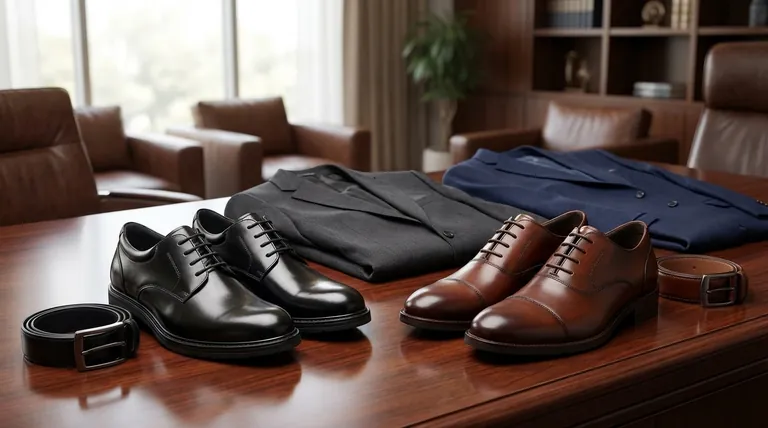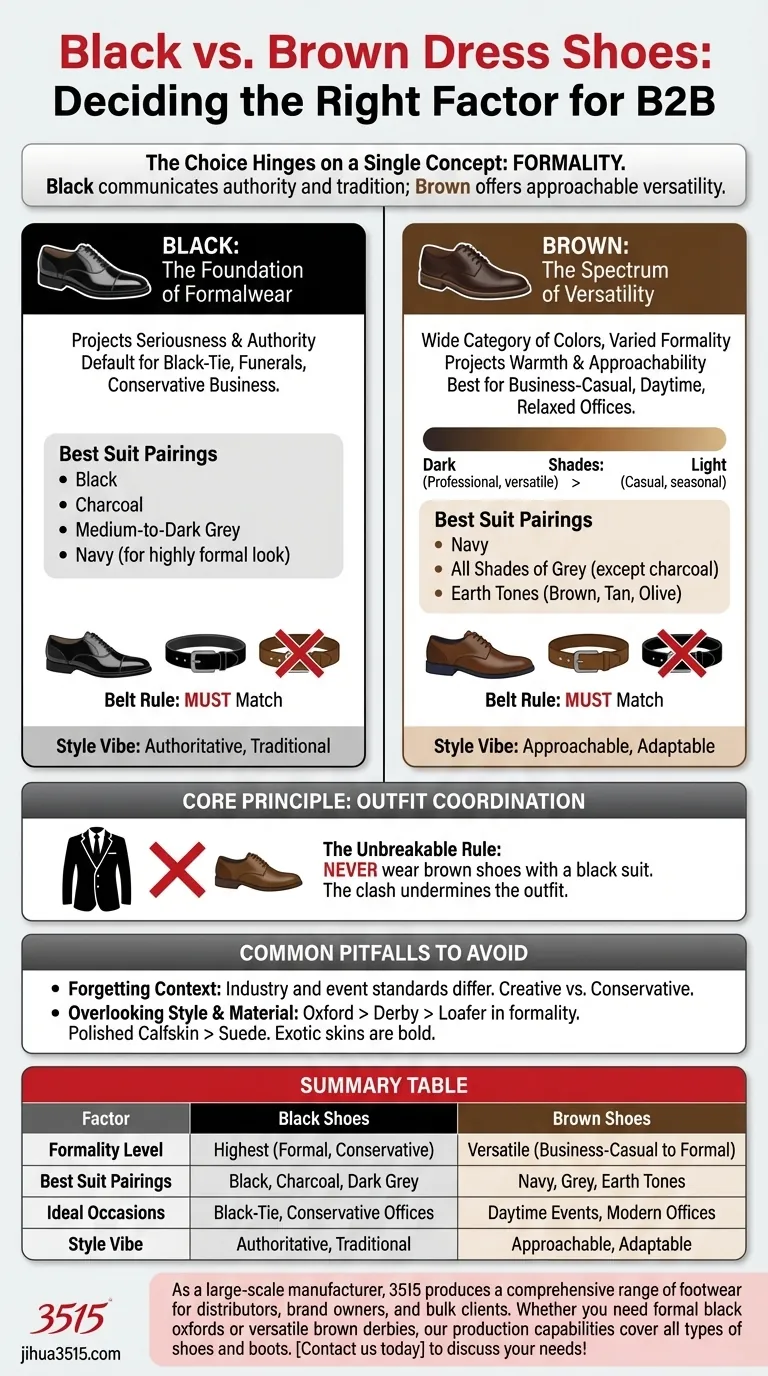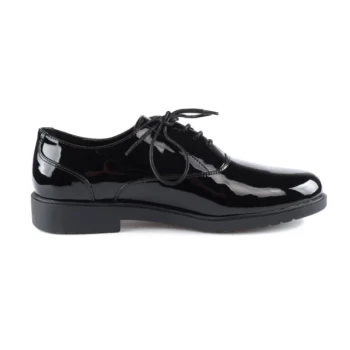The choice between black and brown dress shoes hinges on a single concept: formality. Black is the undisputed champion of formal and business attire, communicating authority and tradition. Brown offers a spectrum of versatility, projecting a warmer, more approachable style that excels in business-casual and daytime settings. The correct choice is determined by the occasion, the dress code, and most importantly, the color of your suit or trousers.
Choosing the right shoe color isn't about abstract rules; it's about understanding the language of professional attire. Black communicates ultimate formality, while brown conveys approachable versatility, making each the correct tool for a specific context.

Decoding the Formality Spectrum
To choose correctly, you must first understand the distinct message each color sends. They are not interchangeable and occupy different positions on the scale of professional dress.
Black: The Foundation of Formalwear
Black is the most formal color for leather goods. It is the default, and often only, choice for black-tie events, funerals, and the most conservative business environments.
It projects an image of seriousness and authority. When in doubt for a critical business meeting or a formal evening event, black is always the safest and most appropriate choice.
Brown: The Spectrum of Versatility
Unlike the singularity of black, "brown" is a wide category of colors, each with its own level of formality.
Darker shades like chocolate or oxblood are highly professional and can be worn with most business suits. Lighter shades like tan or cognac are progressively more casual, best suited for relaxed office environments, daytime events, and seasonal fabrics like linen or light cotton.
The Modern Context
The old rule of "no brown in town" once dictated that brown shoes were too rustic for city business. While this is no longer a strict rule, it serves as a useful reminder of black's dominance in the most traditional and conservative professional settings.
The Core Principle: Outfit Coordination
A shoe's appropriateness is not determined in a vacuum. It is defined by its relationship to the rest of your outfit, primarily your trousers and your belt.
Pairing with Suit Colors
This is the most critical element. Certain pairings are classic, while others are considered mistakes.
- Black Shoes: Pair with black, charcoal, and medium-to-dark grey suits. They are also acceptable with navy suits for a highly formal look.
- Brown Shoes: Pair with navy, all shades of grey (except charcoal), and earth tones like brown, tan, and olive.
- The Unbreakable Rule: Never wear brown shoes with a black suit. The clash in formality is jarring and undermines the entire outfit.
The Importance of the Belt
Your belt must match your shoes in both color and finish. Brown shoes require a brown belt, and black shoes require a black belt.
This detail is a clear signal that you understand the principles of being well-dressed. A mismatch here is one of the most common and easily avoidable errors.
Common Pitfalls to Avoid
Navigating shoe color is straightforward once you internalize the principles, but a few common mistakes can instantly signal a lack of attention to detail.
Forgetting the Context
A beautiful pair of dark brown oxfords is an excellent business shoe. However, it is still inherently less formal than a basic pair of black oxfords.
Always consider your industry and the specific event. A creative agency has different standards than a conservative law firm or bank.
Overlooking Style and Material
Color is only part of the equation. The style of the shoe—an oxford being more formal than a derby, which is more formal than a loafer—also plays a crucial role.
Likewise, material matters. A polished calfskin is more formal than suede. Exotic skins like crocodile or alligator make a bold statement about wealth and should be worn judiciously. A black suede loafer may be less formal than a dark brown calfskin oxford.
Making the Right Choice for Your Wardrobe
Use your professional goals and typical environment to guide your investment. Building a functional shoe collection is about acquiring the right tools for the job.
- If your primary focus is maximum formality for a conservative environment: Your first and most important purchase should be a pair of black leather cap-toe oxfords.
- If your primary focus is versatility for a modern business-casual office: A dark brown leather derby or loafer will provide the greatest flexibility across different trousers and suits.
- If you are building a complete and versatile collection: Secure one high-quality pair of black oxfords first, then add a dark brown shoe, followed by a lighter tan or oxblood option.
Mastering these principles allows you to use your footwear not just as an accessory, but as a deliberate tool for professional communication.
Summary Table:
| Factor | Black Shoes | Brown Shoes |
|---|---|---|
| Formality Level | Highest (formal, conservative) | Versatile (business-casual to formal) |
| Best Suit Pairings | Black, charcoal, dark grey | Navy, grey, earth tones |
| Ideal Occasions | Black-tie events, conservative offices | Daytime events, modern offices |
| Style Vibe | Authoritative, traditional | Approachable, adaptable |
As a large-scale manufacturer, 3515 produces a comprehensive range of footwear for distributors, brand owners, and bulk clients. Whether you need formal black oxfords or versatile brown derbies, our production capabilities cover all types of shoes and boots to meet your market demands. Let us help you stock the perfect collection — contact us today to discuss your needs!
Visual Guide

Related Products
- Wholesale Women's Leather Derby Shoes Custom Factory Production
- Comfortable Block Heel Pumps Wholesale & Custom Factory Production
- Wholesale Comfortable Business Casual Shoes Custom Manufacturing
- Wholesale Modern Business Shoes with Dial Closure System for Bulk Orders
- Customizable Slip-On Safety Shoes Direct from the Factory for Wholesale
People Also Ask
- What are the key differences between men's and women's work boots? Ensure Safety & Comfort with the Right Fit
- What are the key features of high-quality leather in shoes? Invest in Durability and a Perfect Fit
- What are the benefits of classic black lace moc toe shoes? Achieve Polished, Versatile Style
- Why are quality shoes important for overall appearance? The Anchor to a Polished Impression
- How should leather shoes be cleaned after daily use? A Simple 4-Step Guide for Longevity



















